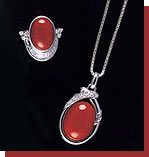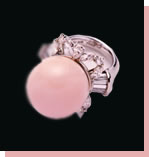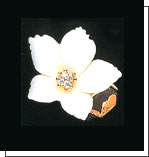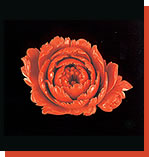 |
| Biologically speaking,
precious coral belongs to octocorallia, whereas coral reefs
belong to hexacorallia. They are completely different species
of coral. |
 |
 |
Precious coral polyps are divided into eighths.
Precious coral lives quietly at deep sea level more than 100m〜1200m
below the surface where light from the sun cannot not reach.
Precious coral eats plankton in the sea and grows slowly.
Precious coral skeleton is firm and once it is polished it has
a beautiful sheen.
Thus, its jewelry has been loved by both the East and West for
thousands of years. |
 |
 |
| In contrast to the eight tentacle precious
coral, coral reef has six or more tentacles which are called
coral polyps. It forms coral reefs such as the table coral and
coral mortar, and contains hundreds of different kinds of coral
reefs and sea anemone or coral stone.Coral reef needs sunlight
and lives in warm shallow water up to 50m deep in tropical and
subtropical coastal habitats such as the Australian Great Barrier
Reef. Coral reef grows fast up to 8~10cm. Coral reefs are soft
and fragile so that their feature does not fit making into jewelry. |
 |
|
 |
 |
 |
 
The red coral that can only be found in the waters near Japan
has earned the standard of excellence for coral. It grows in
deep waters, at a depth of 100-300 meters. Japanese red coral
is a high quality material often used in top, high-priced jewelry
around the world. |
 |
 
Light pink coral is particularly loved by European woman. Comparing
it to the skin color of an angel, it was named "Angel Skin."
Nowadays, the Angel Skin coral material is extremely hard to
find and, thus, very precious. |
 |
 
White coral is the material favored by top jewelry brands worldwide
and is gaining popularity in recent years. The pure white color
is delicate and warm and compliments a variety of skin tones.
|
 |
 
Momo coral grows the fastest and largest among precious coral.
For the Japanese market, it is often used in sculptures and
for the European market is used to accent precious stone jewelry.
In both Japan and Europe, momo coral is gaining the attention
of experienced collectors because of its calm tone and suitability
to larger pieces of jewelry. |
| |
 |